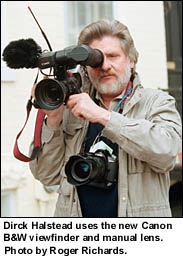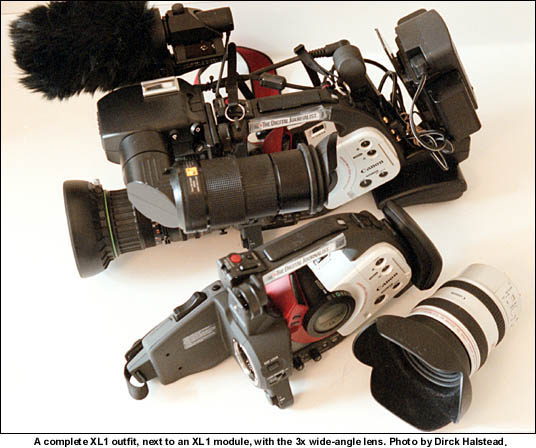New CANON XL1 Accessories A Platypus Field Review
The camera they introduced had a relatively small body, that contains the tape recorder and heart of the system. It was designed to look and feel like a 16mm film camera, rather than the traditional "box" of ENG cameras. In addition to the body, the rest of the package was made up of the lens (a choice of standard 16x zoom, and a spectacular 3x wide angle), and a viewfinder-mic assembly. In theory, a photojournalist could set off on a trip to a third-world country carrying the camera, plus a spare body in case something happened to the first one.
If there were any glaring problems with the camera, they were in its viewfinder and auto-focus lens design. Almost all consumer and most prosumer video camcorders feature a full-color LCD finder. The reasoning is that most users want to see the viewfinder image in color. All professional camcorders used by the broadcast industry utilize black and white viewfinders. These extremely sharp, bright black and white viewfinders make it easy for the photographer to see critical focus. Pros never use autofocus because even the best auto-focus systems can not be depended upon to maintain sharp focus 100 percent of the time. In broadcast journalism, that kind of constant focus means continuing to get a paycheck. A pro will frame his or her shot, rack out the zoom to maximum telephoto, snap focus, then pull the zoom back for the shot. A good camera operator can do this in a heartbeat.
When looking at the image through a color finder, the eye is deceived. Things that look sharp in the viewfinder, can turn out to be soft when the tape is viewed. In addition, any LCD display will look brighter or darker depending on the angle at which the eye views the screen. If you are reading this on a laptop, just tilt your screen back and forth and you will see what I mean. When setting manual exposure, which is another thing the pros do, you can misread your exposure by more than a stop. So, if this is a problem, why not simply put a black and white finder on the XL-1? The answer is that it's not that simple. Believe it or not, a black and white finder uses much more power than a color finder due to the fact that a color finder is an LCD device, while the black and white viewfinder is really a little TV set. It contains a cathode ray tube that eats power. Canon came up with a solution, first they made a voltage convertor that fits into the battery compartment, and changes the EVF voltage to match the BP batteries. Ikegami, a manufacturer of broadcast cameras, and a leader in the field, made the viewfinder for them. The engineers came up with a superb 1.5-inch viewfinder, with contrast and brightness controls that stack up against the best in broadcast cameras. They put in a nifty feature, which resides just above the lens, that allows you to turn on a little light so you can see the settings. One special note, you must be sure to use the supplied metal mic shield which isolates the camera from possible audio interference. The viewfinder retails for $1,999 So now that they fixed the viewfinder, Canon turned its attention the next big problem, which was the lens. This was a bit of pill to swallow, since the engineers had prided themselves on what they felt was one of the best auto-focus lenses in the industry. It took quite a bit of convincing by the professional markets division, but eventually they understood that the auto-focus lens had one huge problem - the focus collar continually rotates. That is, as you turn the collar to focus, it rotates through the entire 360 degree range and keeps on going. As a result there was never any "there" there.
They produced a fully mechanical lens, no auto-focus, no power zoom, no stabilization, but one that communicated electronically to the camera body, permitting use of functions that include AE shift, Auto White Balance, Exposure Lock, and Slow Shutter Speeds. In keeping with their reputation as lens makers, they used a low-dispersion glass that suppresses chromatic aberration, and maintained the highest quality in color, clarity and contrast through the full zoom range. The lens offers a 14X focal range, which would be the 35mm equivalent of a 41 to 577mm zoom. SOME SPECIAL NOTES OF CAUTION for first time users of a mechanical lens,and monochromatic viewfinder. These are professional tools, aimed at professional camera operators who have experience with Betacams. With no stabilization, it takes experience to hold a mechanical lens, especially on long zoom, steady. A pro will understand what Canon has done, with an iris where it should be, on the lens barrel, but it may be confusing to a novice videomaker. All broadcast lenses have a "back focus" setting, at the rear of the lens housing. Its purpose is to be able to allow the operator to quickly change zoom and focus where the purpose is to rack from a foreground object to a background scene. You must ALWAYS check to make sure that the back focus is set to the F.B. mark on the barrel. If you don't the focus will wander as you zoom. What Canon has done is to make the front end of the XL1 feel and act like a Betacam. The lens sells for $1799 I used the combination of black and white finder and mechanical lens on a recent documentary shoot in Las Vegas and it was a joy to use. I have been showing the camera with the new viewfinder and lens to my friends, who are broadcast shooters, and they are more envious than ever. They are beginning to get the idea...we are really serious about this stuff. To buy one of these items, contact VIDEOSMITH for the best deal, at http://www.videosmith.com. Visit Canon's website for more information about their DV Camcorders. |
 As
any regular reader of The Digital Journalist is well aware, we have been
enthusiastic about Canon's top-of-the-line video camcorder, the XL-1, since
its introduction two years ago. It still is leading the way as far as innovative
design and functionality are considered. The key ingredient in its design
was to envision the camera as a modular unit, rather than a sealed box
with a built-in lens. Taking a page from the still camera division handbook,
they realized that professional photographers would want the ability to
change lenses and switch from an ultra-wide angle to a super-long telephoto.
As
any regular reader of The Digital Journalist is well aware, we have been
enthusiastic about Canon's top-of-the-line video camcorder, the XL-1, since
its introduction two years ago. It still is leading the way as far as innovative
design and functionality are considered. The key ingredient in its design
was to envision the camera as a modular unit, rather than a sealed box
with a built-in lens. Taking a page from the still camera division handbook,
they realized that professional photographers would want the ability to
change lenses and switch from an ultra-wide angle to a super-long telephoto.


 On
a mechanical lens, such as used on professional broadcast and film cameras,
there is a defined focus position. In other words, if you set the lens
on 10 feet, that particular setting would always be in the same place.
A seasoned professional often can "feel" the focus on a mechanical lens
before his eye even recognizes it. So, back to the drawing board.
On
a mechanical lens, such as used on professional broadcast and film cameras,
there is a defined focus position. In other words, if you set the lens
on 10 feet, that particular setting would always be in the same place.
A seasoned professional often can "feel" the focus on a mechanical lens
before his eye even recognizes it. So, back to the drawing board.